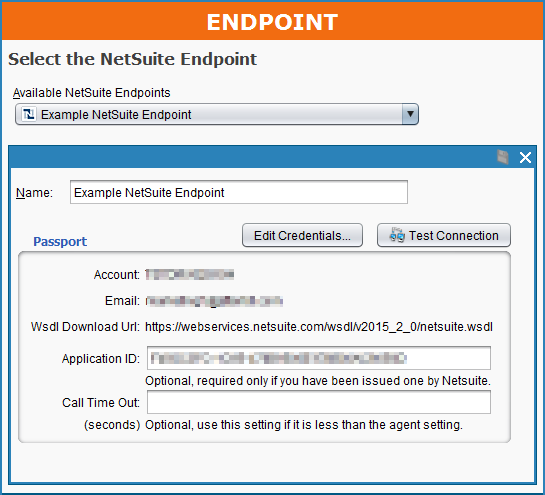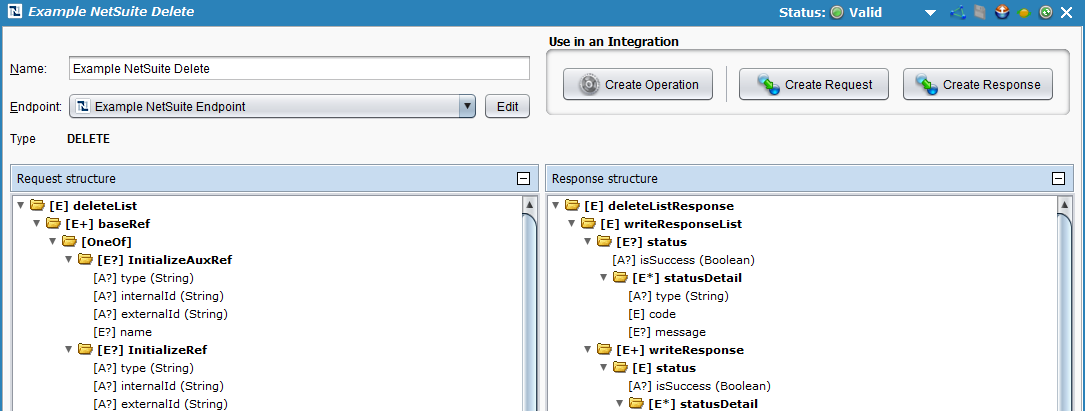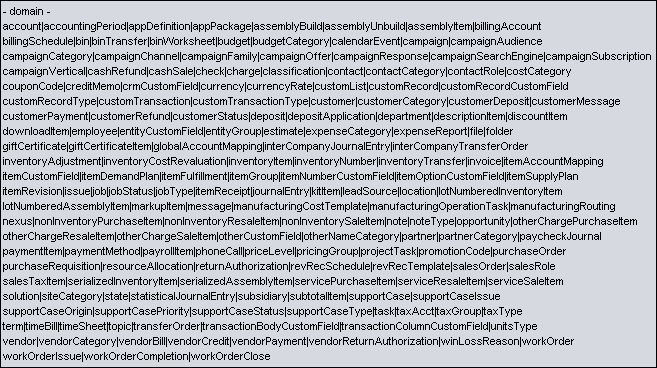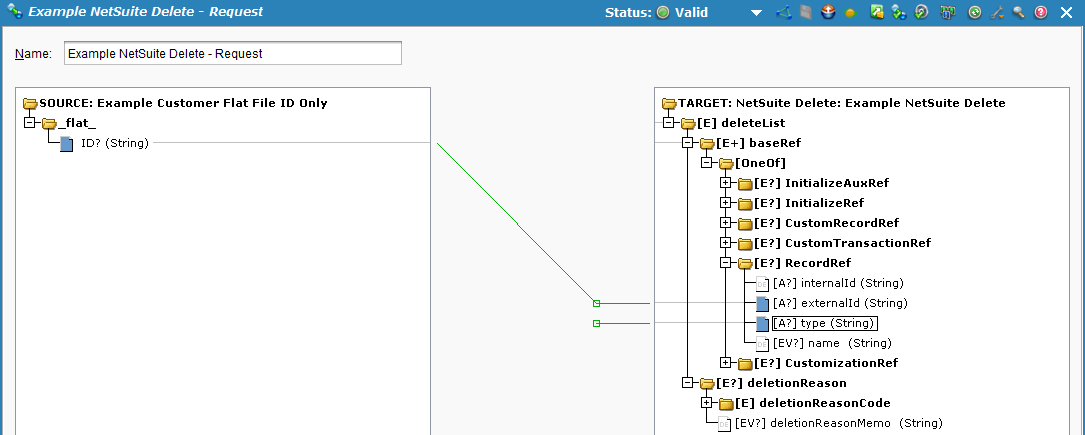NetSuite connector Delete¶
The NetSuite delete activity available within the NetSuite connector allows you to delete existing records in a connected NetSuite instance using Jitterbit.
Note
Before you set up a NetSuite delete operation, you will need to have a NetSuite endpoint defined. For more information on creating an endpoint, see NetSuite connector endpoint.
This page describes how to delete existing NetSuite records by ID using a simple example with external IDs provided in a CSV file through Jitterbit. This completes the demonstration using example records created and updated during the walkthroughs for NetSuite connector create, NetSuite connector update, and NetSuite connector upsert.
Example
For reference, see the Jitterpak NetSuiteExample.jpk and accompanying files in NetSuiteSampleFiles.zip. Unzip the NetSuiteSampleFiles.zip to your "C:\" drive, or if you unzip to another directory make sure to edit the source and target directories in the operations. If this is your first time using a Jitterpak see Importing a Jitterpak.
The following sections are divided up into beginning the delete activity, defining the operation components, and deploying and executing the operation.
Creating a NetSuite Delete operation¶
Note
If you are not already familiar with Jitterbit, see Get started or Design Studio for detailed information on how to use the product.
-
Within your project within Jitterbit Studio, there are several ways to begin a new NetSuite delete activity. Each of the following options will start the NetSuite Delete Wizard to guide you through the process.
- Go to File > New > Connectors > New NetSuite Delete.
- In the tree on the left under Connectors, right-click on the NetSuite category, then select New NetSuite Delete.
- In the tree on the left under Connectors, double-click on the NetSuite category, then right-click on New NetSuite Delete and select New NetSuite Delete.
- In the top toolbar, click the connector icon (orange jigsaw piece)
 . In the popup, select NetSuite, then select NetSuite Delete.
. In the popup, select NetSuite, then select NetSuite Delete.
-
The Endpoint screen of the NetSuite Delete Wizard should open in the main view of Studio. This screen asks to select the endpoint that you would like to delete records from. You should have already set up your endpoint in NetSuite connector endpoint. Use the dropdown to select the appropriate endpoint. Click Finish to complete the wizard.

-
Jitterbit will then proceed with creating a NetSuite API request and response structure that will allow records to be deleted within your connected NetSuite account. A new tab should appear in Studio called NetSuite GetLists. You can rename your GetList activity here if desired; in the example ours is called "Example NetSuite Delete." You can also use the + - buttons or arrows to expand all elements within each structure.

-
Next, on the same screen, click the button Create Operation located under Use in an Integration in the upper right corner. This will create the Jitterbit operation that will delete existing customer data in NetSuite.
-
A new tab should open in Studio called Operations, containing a graphical representation of the delete activity.

Note
The icons for Source, Request, Response, and Target in the image above are placeholders for the operation components, which we will define in the next section.
Save your operation by clicking either the single disk icon to save just this operation or the multiple disk icon to save all changes in your integration project. You should see the asterisk on the Operations tab and operation title disappear as your new delete activity is now created and saved to your project.
Defining the operation components¶
Next we need to define the other components of the operation that appear within the graphical representation, including Source, Request, Response, and Target.
For each, the instructions below direct you to return to the graphical representation of the operation you have created and double-click each icon to configure each component. As an alternative, you could also create the Response and Target separately and then drag and drop them from the tree on the left directly onto the icons in the visual representation of your operation.
For purposes of this walkthrough, we provide the following examples for reference above: Jitterpak NetSuiteExample.jpk and accompanying files in NetSuiteSampleFiles.zip. Many different types of data can be used for each component of the operation. To learn more about additional customization options, refer to the Design Studio section of our documentation.
-
Source: In the example, we use a CSV file as the input request to delete existing customer records by ID. These same IDs originally were mapped to NetSuite External ID during the example NetSuite create, update, and upsert operations.
Note
NetSuite delete supports deletion of object data by either ExternalID or InternalID.
For this example we will use the same source created in the NetSuite connector GetList example. If you have followed this walkthrough, to use the same CSV file, double-click on the Source icon and select the existing source CustomerGetListRequest.csv.
If creating from scratch, first double-click on the Source icon, then click the button Create New Source and give your source a Name (e.g. CustomerDeleteRequest.csv). Next, for this example, we are using a private agent with local files enabled, and thus select a Type of "Local File" and then Browse to the location. If you are using the example files, the Folder is 'C:\NetSuiteSampleFiles' and the Get Files is 'CustomerGetListRequest.csv'. We will also expand the Options and set Ignore Lines to First: '1' since our CSV file uses a header row.
Note
A variety of source types are available in Jitterbit. See Sources for more.
-
Target: Double-click on the Target icon. In the example, we will record the response from NetSuite to an XML file. Click the Create New Target button, give your target a Name (e.g. CustomerDeleteResponse.xml), and again select a Type of "Local File" and Browse to a location on the private agent where we want to save the data. In the example, the Folder is 'C:\NetSuiteSampleFiles' and the Filename is 'CustomerDeleteResponse.xml'.
Note
You can also output to a variety of different target types. The type does not have to be the same as the source type. See Targets for options.
-
Request: Double-click on the Request icon and select Create New Transformation. This will open the Transformation Wizard which will walk you through creating the request.
Note
Additional information on request structures is provided under Transformations.
-
On the first screen, Name, provide a Name for your transformation or leave as the default. Then use the Source dropdown to select the source type. For the example we used a CSV file, which is considered "Text." Click Next to continue.
-
On the next screen, Source, use the Available File Format Definitions dropdown to select the existing "Example Customer Flat File ID Only" definition that was created in the NetSuite connector GetList example.
If creating from scratch, use the Available File Format Definitions dropdown to select Create New. This will open up additional options for defining a new file format. Provide a Name for the new file format (in the example we call ours "Example Customer Flat File ID Only"). To create the text definition based off of our existing CSV file, select Create From File, then in the popup browse to the local 'CustomerGetListRequest.csv' file. Click Finish to continue.
-
The Transformations tab should open where you can complete your mapping. Use the + to expand the source and target items in each tree. Then drag and drop each field you would like to be mapped from one tree to the other. In this case, the ID provided in our CSV file maps to the 'externalId' field in NetSuite.
Next, we need to define the object for the delete. To do this, double-click on the 'type' field below 'externalId' and enter "customer" within double quotes into the Formula Builder to delete the Customer records associated with the provided IDs:
<trans> "customer" </trans>Note
The supported types that can be deleted with a NetSuite delete operation are shown when you hover over 'type.'

Your final transformation mapping should look similar to that shown below:

-
-
Response: Right-click on the Response icon and select Pass-Through. This will allow us to pass through all the data associated with the deleted records to the output file.
-
Optional Scripts: You can find additional script functions to use during your Transformation mapping or separately as Scripts under the Formula builder section. For additional information, see NetSuite connector advanced.
Deploying and executing the operation¶
With the NetSuite delete activity fully configured, we are ready to deploy and execute the operation.
-
From the Operations tab, click the deploy
 icon.
icon. -
Then click the execute
 icon to place the operation in the queue for execution.
icon to place the operation in the queue for execution. -
In the lower portion of the screen, the Operation monitor should indicate that your operation was run successfully. If not, you can double-click the Status icon to view any log messages.
-
You should also now see the output response that was passed through to your target file. In the example, the file is now created in 'C:\NetSuiteSampleFiles\CustomerDeleteResponse.xml'. The file should contain all of the data on the customer records deleted by ID.
-
In addition, when you check your NetSuite account, you should find that the deleted customer records no longer exist.
Note
You can find more information about the API call to NetSuite within the Web Services Usage Log available in NetSuite under Setup > Integration > Web Services Usage Log. This provides detailed information about success/failure as well as the request and response that was sent to Jitterbit.